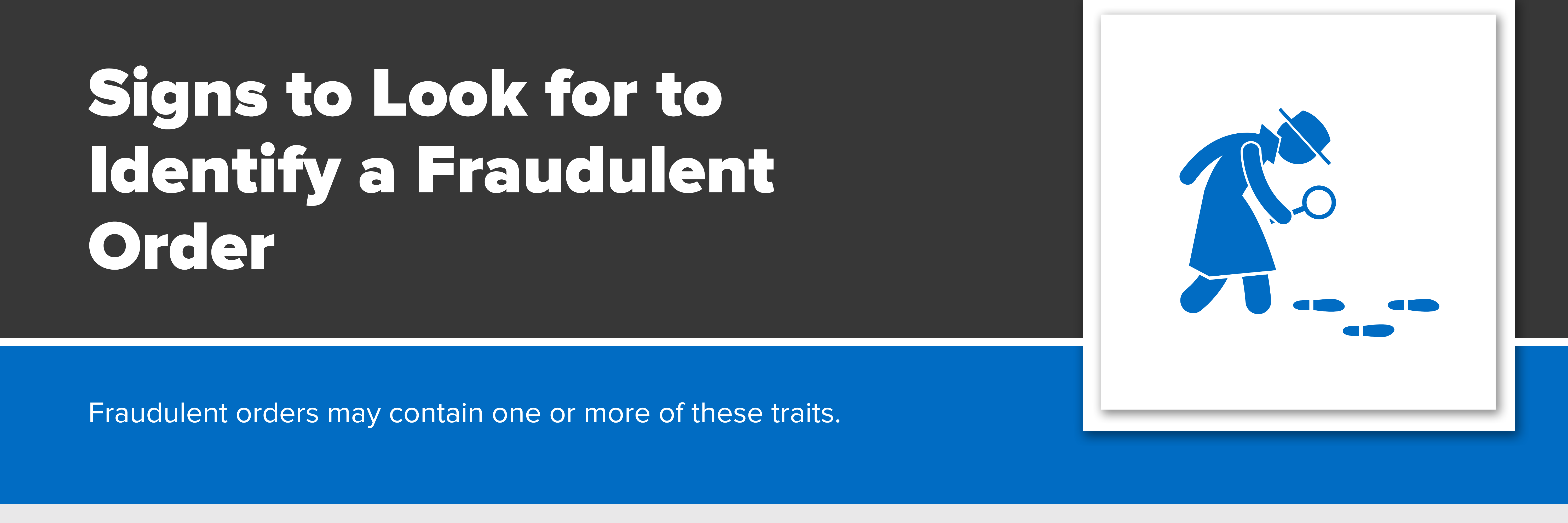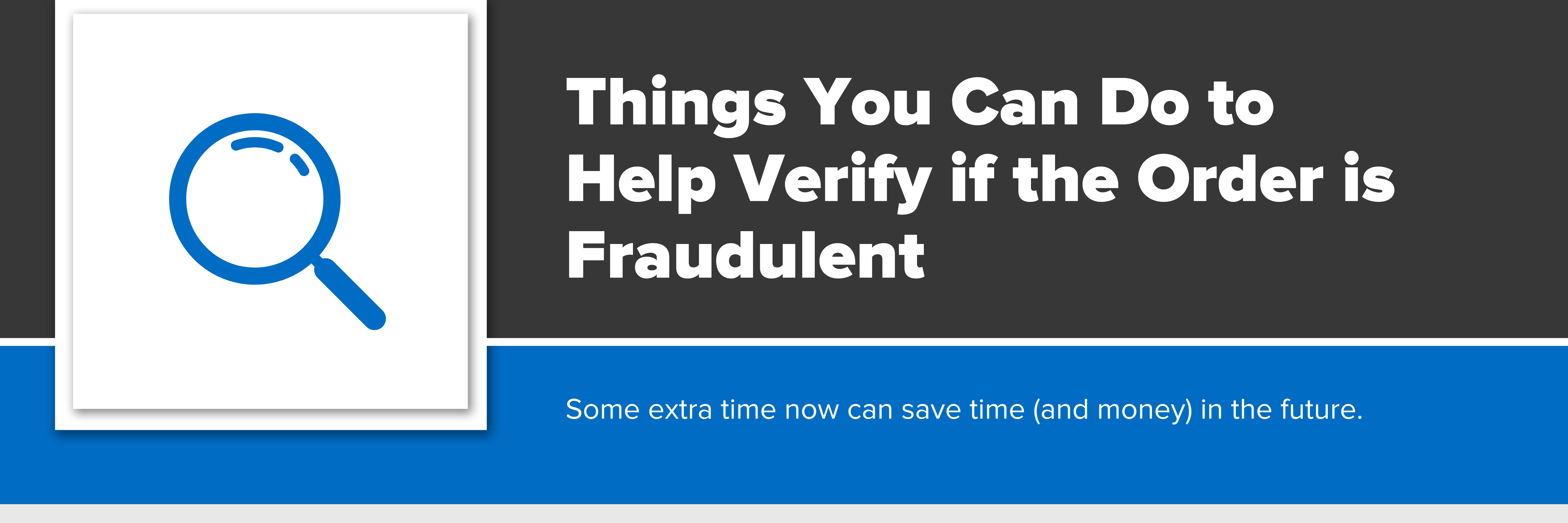Preventing Fraud | A Guide to Help Identify & Prevent Fraudulent Orders

Fraud 101
Fraud is an unfortunate fact of life for merchants. This is especially true for businesses like ours that conduct transactions online and on the phone. We move tens of millions of dollars worth of products around the world each year. Because of this, fraudsters who target us are not limited by geography. They can place large numbers of fraudulent orders from anywhere, hoping to catch us unaware. With access to complex technology getting easier around the world, many fraudsters simply play a game of probability, seeing how wide of a net they can cast in the shortest amount of time possible. Unfortunately, this means any and all businesses can be targeted.
If you don't prepare your business to identify and control fraud, you're ultimately preparing to see your profits disappear. It's for this reason that our Credit Team has made it their mission to root out as much fraud as possible. Over the years, they have identified a number of signs that an order may be fraudulent. Though it’s impossible to stop all fraud, knowing what to look for can cut it down considerably.
First off, stopping fraud is a collaborative effort. Everyone at Instrumart who handles orders is familiar with ways to identify fraud and acts as our first line of defense. If they see a sign of fraud, even if it turns out to be a legitimate order, it is investigated. It may take a bit more time but the results are well worth the effort. Working together with other businesses—colleagues, customers, vendors, or even competitors—is also a successful strategy for stopping fraud. Sharing information or tips, and asking for assistance when it’s needed can go a long way toward protecting your company.
With all this being said, let's dive in.

Signs to Look for to Identify a Fraudulent Order
Fraudulent orders and purchase orders may contain one or more of these traits:
- The order is very large but has an overnight shipping method.
- The buyer doesn't care how much the order costs (i.e. paying for expedite fees, large shipping costs, or taxes).
- The order contains instruments that have a high resale value or would be easy to sell.
- The purchase order is for a variety of products that you might not even sell. Fraudsters tend to send these out in bulk with no real care as to who is receiving them.
- An individual buys an instrument that is normally only used commercially.
- The order has different “bill to” and “ship to” addresses.
- The order uses free email accounts or ones that are from countries you don't normally do business with.
- The buyer only contacts you by email or relay service, even if you ask them to call you.
- There are spelling errors or the flow of the email makes you think that the primary language your business uses is not the first language of the sender.
- The email request is in all caps or all lowercase.
- The order is placed late at night. Most fraudulent orders in the US are made between midnight and 2:00 AM.
- The ship-to address is a freight forwarder or a hotel.
- The email address uses:
- A name that has no apparent connection to the customer's name or includes random characters could be attempts to mask the identity.
- A domain that does not match the company's real domain. Sometimes a fraudster uses a domain with extra, missing, or different letters that are meant to escape a non-watchful eye. Here are some examples:
- name@harvard-edu.com is meant to look like harvard.edu but the fraudster added "-edu" to their .com domain.
- name@instrmart.com is meant to look like instrumart.com but the fraudster removed the "u."
- name@lnstrumart.com is meant to look like instrumart.com but the fraudster used a lowercase L instead of a lowercase i. Using a lowercase L in place of uppercase or lowercase I is very common.
- name@instrurnart.com is meant to look like instrumart.com but the fraudster used an r and an n together to look like an m.
- name@instrurrart.com is meant to look like instrumart.com but the fraudster used two r's to look like an m.
- name@sleepyhollowim.com is meant to look like sleepyhollowinn.com but the fraudster used an m instead of two n's.
- The order is for a bulk quantity of products that are rarely bought in large quantities.
- The order is one of several placed in a short period of time by the same customer.
- Instead of working with the seller directly, the customer contacts the shipping company after the order ships to redirect it.

Things You Can Do to Help Verify if the Order is Fraudulent
Taking the small amount of extra time it takes to verify whether or not an order is fraudulent can help save your business time and money in the future.
Do Your Research on the Buyer
- Google the person or business and verify their name, address, and phone number.
- Use reverse look-up websites like Superpages or TruePeopleSearch to find out if the information checks out. These kinds of websites can do a reverse check on both phone and address.
- If you find a different phone number online for the person or business, call that number and ask if they are actually placing the order.
- Some fraudsters even know who your regular customers are, so review each order carefully.
Make the Call—Literally
One of the easiest ways to determine that an order is legitimate is to confirm the order with the customer by phone. We often use Google to find the person whose credit card is being used, and if we find a phone number that is different from the one we were given, we will call the number from Google and talk to them about the order. This is especially good to try for orders placed by businesses. We will look for the main number of the business on the web, and then call that number and ask to be connected to the person who placed the order. We often reach out to the purchasing or accounts payable department of the company to verify that an order is legitimate. If the customer does not answer the phone, be sure to leave a message. Ask them to call back to confirm the order before anything else proceeds. You may be dealing with a fraudulent order if the customer does not call back to confirm.
You know that you are dealing with fraud when the customer denies placing the order, the phone number is disconnected, or the person answering the phone has never heard of the buyer's name. The latter normally happens when a random phone number is used in order to place the order. Sometimes the fraudster will submit the actual phone number of the person whose card was stolen. If the cardholder did not authorize the charge, you should suggest that they call their credit card company to report their card as stolen and/or dispute the transaction.
You can also talk to the cardholder's bank to verify the name and address on the card. If you are suspicious, you can ask the bank if they will contact their customer to verify that it is a good order. Most banks will do this. If you start with the bank's fraud department, you are more likely to get help than just the regular customer service person.

Want to Learn More About Instrumart?
See what’s happening Inside the Mart on our blog, read about what we stand for as a company, or meet the team.










